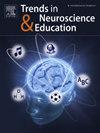在动机相关的大脑网络中,心态是否与功能连接有关:一项针对青少年的静息状态fMRI研究
IF 3.4
Q2 NEUROSCIENCES
引用次数: 0
摘要
摘要本研究旨在探讨青少年奖赏回路和执行控制网络的全脑功能连接模式及其与智力成长心态的关系。方法研究了尾状核和壳核(奖赏回路)、前扣带背皮层(dACC;59名13-16岁青少年的执行控制区)。在基于种子的分析中,成长心态被用作协变量。结果我们的发现揭示了三种预定义种子的预期全脑功能连接模式。与文献相反,种子和大脑所有其他体素之间的这些功能连接模式都与成长心态无关。结论:目前的研究表明,在静息状态的神经连接中,成长心态的神经表征并不一致,可能取决于环境或文化差异。本文章由计算机程序翻译,如有差异,请以英文原文为准。
Is mindset related to functional connectivity in motivation-related brain networks: A resting-state fMRI study in adolescents
Introduction
the aim of this study was to investigate whole-brain functional connectivity patterns of the reward circuitry and executive control network, and their associations with growth mindset of intelligence in adolescents
Methods
we investigated seed-based functional connectivity of three pre-defined seeds, the caudate and putamen (reward circuitry), and dorsal anterior cingulate cortex (dACC; executive control region) in 59 adolescents between 13–16 years old. Growth mindset was used as covariate in the seed-based analysis
Results
our findings revealed the expected whole-brain functional connectivity patterns of the three pre-defined seeds. In contrast to the literature, none of these functional connectivity patterns between the seeds and all other voxels of the brain were related to growth mindset
Conclusion
the current study suggests that the neural representation of a growth mindset is not consistently observed in resting-state neural connectivity and might depend on contextual or cultural differences.
求助全文
通过发布文献求助,成功后即可免费获取论文全文。
去求助
来源期刊

Trends in Neuroscience and Education
NEUROSCIENCES-
CiteScore
6.30
自引率
6.10%
发文量
22
审稿时长
65 days
 求助内容:
求助内容: 应助结果提醒方式:
应助结果提醒方式:


